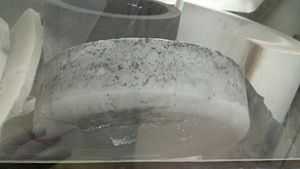FLiNaK

FLiNaK is the name of the ternary eutectic alkaline metal fluoride salt mixture LiF-NaF-KF (46.5-11.5-42 mol %).[1] It has a melting point of 454 °C and a boiling point of 1570 °C. It is used as electrolyte for the electroplating of refractory metals and compounds like titanium, tantalum, hafnium, zirconium and their borides. FLiNaK also could see potential use as a coolant in the very high temperature reactor, a type of nuclear reactor.
Coolant
FLiNaK salt was researched heavily during the late 1950s by Oak Ridge National Laboratory as potential candidate for a coolant in the molten salt reactor because of its low melting point, its high heat capacity, and its chemical stability at high temperatures.[2] Ultimately, its sister salt, FLiBe, was chosen as the solvent salt for the molten salt reactor due to a more desirable nuclear cross section.[3] FLiNaK still gathers interest as an intermediate coolant for a high-temperature molten salt reactor where it could transfer heat without being in the presence of the fuel.[4]
Chemistry
Fluoride salts, like all salts, cause corrosion in most metals and alloys. Flinak is different from flibe in the sense that is a basic melt—or it has an excess of fluorine ions. As flinak melts, all three components are alkali fluorides and therefore disassociate into positive and negative ions. The concentration of molten fluorine ions are able to corrode any metallic structures if it is energetically favorable. This is in contrast to flibe, which in a 66-34 mol% mixture will be a chemically neutral mix, as fluorine ions from LiF are donated to BeF2 to create the tetrafluoroberyllate ion BeF42−.
See also
References
- ↑ http://www.energyfromthorium.com/pdf/FFR_chap12.pdf Lane, James A. Fluid Fuel Reactors. Reading, MA: Addison-Wesley Pub, 1958, p. 570
- ↑ http://www.energyfromthorium.com/pdf/FFR_chap12.pdf Lane, James A. "Chemical Aspects of Molten Fluoride Salt Reactor Fuels." Fluid Fuel Reactors. Reading, MA: Addison-Wesley Pub., 1958.
- ↑ http://www.energyfromthorium.com/pdf/FFR_chap12.pdf Lane, James A. Fluid Fuel Reactors. Reading, MA: Addison-Wesley Pub, 1958, p. 574
- ↑ Williams, D. F. (2006). Assessment of candidate molten salt coolants for the NGNP/NHI Heat-Transfer Loop